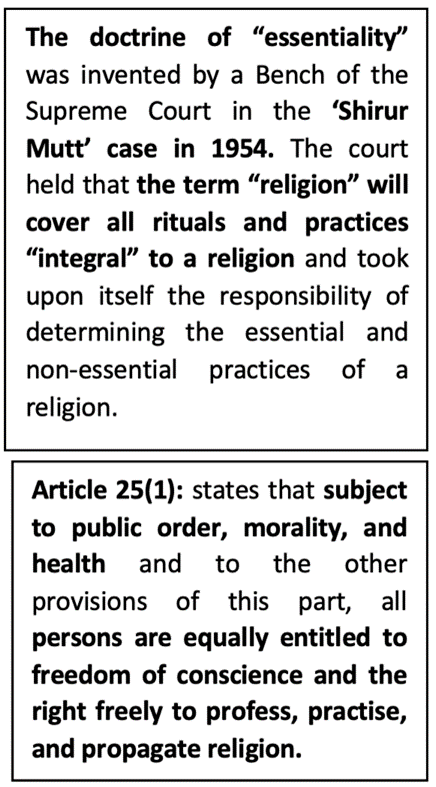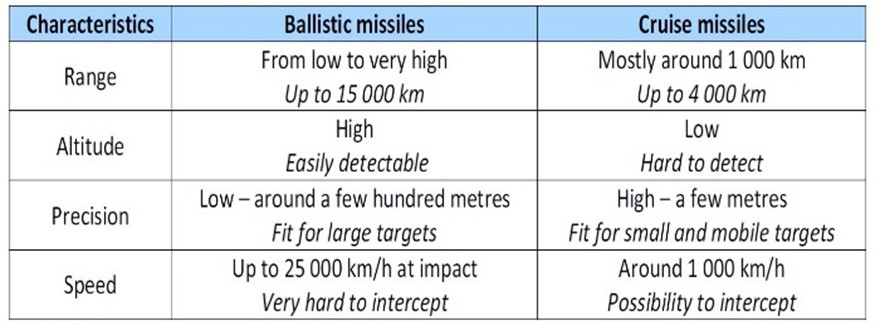Tuesday, 22nd March 2022
World Happiness report 2022
In News
The United Nations Sustainable Development Solutions Network (UN-SDSN) has recently released the world happiness report for the year 2022.
About the News
- The report evaluates levels of happiness by considering factors such as GDP, social support, personal freedom, and levels of corruption in each nation.
- The report is written by a group of independent experts acting in their personal capacities and not necessarily reflect the views of any organization, agency or program of the United Nations.
- Russia and Ukraine, currently at war with each other, have been ranked 80 and 98 respectively as the rankings were compiled much before the Russian invasion of Ukraine
What are the major findings of the report?
- South Asia: Among the South Asian nations, only Taliban-ruled Afghanistan fared worse ranking last at 146 making it the most unhappy country in the world.
- India: It continued to fare poorly in the world happiness index, with its position marginally improving to 136 as against last year’s 139. The report also stated that India was one among the countries that witnessed, over the past 10 years, a fall in life evaluations by more than a full point on the 0 to 10 scale.
- Other Asian: countries including Nepal (84), Bangladesh (94), Pakistan (121) and Sri Lanka (127) managed to get better ranks in the list.
- Globally: Finland topped the list for the fifth time in a row and was followed by Denmark, Iceland, Switzerland, and the Netherlands.
- Western countries: Among other western countries, while the United States managed to bag the 16th position, Britain was ranked 17th and France 20th.
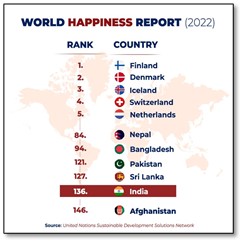
What are the parameters used for happiness report?
- Happiness, benevolence, and trust during COVID-19: The average life evaluations, reflecting the net effects of offsetting negative and positive influences, have remained remarkably resilient during COVID-19.
- For the young, life satisfaction has fallen, while for those over 60, it has risen – with little overall change.
- Worry and stress have risen – by 8% in 2020 and 4% in 2021 compared with pre-pandemic levels.
- On the positive side, the most remarkable change seen during COVID-19 has been the global upsurge in benevolence in 2021.
- Conceptions of progress and well-being: Interest in happiness and subjective well-being has risen sharply with strong public appetite for this conception of progress and the growing availability of data on happiness.
- Social media data to capture emotions: With millions of people sharing their thoughts and feelings online via social media each day, automated analysis of social media data offers exciting promise for measuring trends in emotions.
- As regards the impact of COVID-19, 18 countries showed strong increases in anxiety and sadness during COVID-19 (together with decreases in anger)
- Biological basis for happiness: Genetic studies involving twin or family designs reveal that about 30-40% of the differences in happiness between people within a country are accounted for by genetic differences between people.
- Balance and Harmony: Among positive experiences, Eastern culture gives special value to experiences of balance and harmony.
- The experiences of balance, peace, and calm are more prevalent in Western countries, which also experience the highest levels of satisfaction – and they are less prevalent in poorer countries, including those in East Asia.
- The majority of people in almost every country prefer a calmer life to an exciting one. But that preference is no higher in Eastern countries than elsewhere.
Sources:
Entrance test for central universities
In News
The Central government has recently announced a common entrance test across central universities.
About the News
- The University Grants Commission’s announcement on the introduction of the Central University Entrance Test (CUET) makes the test now mandatory for undergraduate admission at any of the 45 central universities in the country.
- This has come after the announcement of the new National Education Policy (NEP), which advocates the need for an entrance test for university admissions.
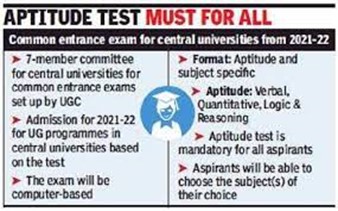
About the Central University Entrance Test (CUET)
- What is it? CUET is a revamped version of Central Universities Common Entrance Test (CUCET) and it is now compulsory for all 45 central universities to adopt it.
- Need: As the burden on higher education aspirants increases with multiple entrance tests, several governments, over the years, have made attempts to replace these entrance tests with a single one.
- Also given the “diversity” in evaluation methods of 12th class students adopted by different Boards where some boards are more generous than others in marking which this gives their students an unfair advantage over others.
- Procedure for Admissions: With this common test, a student’s Board marks will have no role in determining his/her admission to a college or a programme.
- It will be based only on his/her CUET score.
- At best, colleges affiliated to Delhi University or any central university can use Board marks as the minimum eligibility criteria for admission.
- For skill-based courses that have major practical components, such as music, painting, sculpture and theatre, universities will be allowed to conduct practical exams or interviews along with CUET.
- For professional programmes such as engineering and MBBS, central universities will admit through the entrance exams JEE (Main) and NEET respectively.
- CUET Conducting Agency: The National Testing Agency (NTA), which conducts entrance tests such as JEE (Main) and UGC-NET, will conduct CUET for all central universities in the first week of July.
- Test Procedure: It is a three and a half hour computer-based test that will be held in two shifts and can be taken in 13 languages namely, Hindi, Marathi, Gujarati, Tamil, Telegu, Kannada, Malayalam, Urdu, Assamese, Bengali, Punjabi, Odia and English.
- The application window for the examination will open in the first week of April.
- Unlike JEE (Main), there will be no common counselling for admission to central universities based on the CUET score.
- Each university is free to define its admission process based on the merit list prepared by the NTA.
- Does it apply to postgraduate programmes? Conducting admissions to postgraduate programmes through CUET is not compulsory for central universities and thus they are free to adopt CUET for PG admissions or stick to their own admission process for the time being.
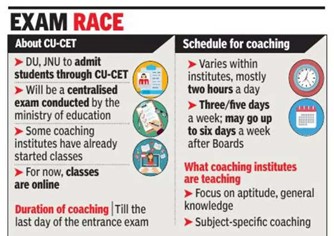
Source:
- Entrance test for central universities:
- UGC announces all central universities will have mandatory entrance test from 2022-23
Image source:
Finlandization option for Ukraine
In News
As a possible solution to the Russia-Ukraine war, “Finlandization” of Ukraine is being discussed.
About the News
- Despite several rounds of talks between the representatives of the two sides, Russia-Ukraine war is not showing any signs of ending any time soon.
- Russia invoked the threat of Ukraine joining NATO as a pretext for the invasion, but Ukrainian President recently acknowledged that his country will not be part of the NATO anytime soon.
- Among the scenarios that have been seen as potentially workable is the “Finlandization” of Ukraine, an idea floated earlier in 2014, the year Russia annexed Crimea

What is “Finlandization”?
- The term refers to Finland’s strict neutrality during the Cold War, enshrined in a 1948 treaty, the ‘YYA Treaty’ (Friendship, Cooperation, and Mutual Assistance Treaty) with Moscow when tensions between the Soviet Union and the West were at a high.
- The treaty ensured Finland that unlike other countries in Eastern Europe, it would not face a Soviet invasion.
- It allowed the country to pursue the path of democracy and capitalism while staying out of the conflict between the great powers.
- But in return, it agreed to stay out of NATO and European military powers and used this positioning to ward off pressure from Moscow to become part of the Warsaw Pact.
- Hence, Finland neither signed the Marshall Plan nor the Warsaw Pact because of the YYA Treaty.
- The 1948 treaty formed the basis of Helsinki-Moscow relations until 1992, when Finland signed a new agreement with post-Soviet Russia.
Arguments in support of Finlandization of Ukraine
- Russia being an immediate neighbour of Ukraine, such a treaty may help the relations between the nations to stabilize.
- Ukraine, formerly a part of the Soviet Union, has increasingly tilted toward the West, economically and politically, while resisting Russian influence.
- An assured neutrality of Ukraine may assuage Russia’s security concerns that hinges on the influence the West may have on its neighbour.
- Ukraine should have the right to choose freely its economic and political associations, including with Europe.
- A neutral Ukraine with an assurance against Russian invasion will have a free hand to deal with other European countries.
- The West making it clear it would not go to war against Russia to defend Ukraine, some experts have argued that “Finlandization” is the best course Ukraine can take.
Arguments against Finlandization of Ukraine
- Such a treaty may allow Moscow a heavy hand in Ukrainian political and foreign affairs, increasing Russia’s sphere of influence in Eastern Europe.
- After signing the 1948 Treaty, although being neutral on paper, Finland was tilted towards Moscow, vocal public criticism of Moscow became impossible with lawmakers surviving on Russian support.
- It will lead to an end of Ukraine’s long term political aim of joining NATO and joining the E.U.
- An imposition of a permanent neutrality on Ukraine should in principle come with something Russia giving up for Ukraine, but the Kremlin has remained silent on this.
- Allowing Moscow to impose a "Finlandization" policy on Ukraine would set a dangerous precedent for other European countries, including the EU.
- In 1992, the YYA treaty ended, and Finland joined the EU. This is a testament to the argument that such a treaty would not stand the test of time.
- Ukraine is not as economically independent and politically stable as Finland, and hence a permanent neutrality may harm the nation’s stability further.
Sources:
World Water Day
On March 22 World Water Day is held every year since 1993. This day highlights the importance of freshwater. This day is used to advocate for the sustainable management of freshwater resources. A core focus of World Water Day is to support the achievement of Sustainable Development Goal 6: water and sanitation for all by 2030. This 2022, the focus is groundwater, an invisible resource with an impact visible everywhere. Groundwater is water found underground in aquifers, which are geological formations of rocks, sands and gravels that hold substantial quantities of water. Groundwater feeds springs, rivers, lakes and wetlands, and seeps into oceans. Groundwater is recharged mainly from rain and snowfall infiltrating the ground. Groundwater can be extracted to the surface by pumps and wells. The idea for this international day goes back to 1992, the year in which the United Nations Conference on Environment and Development in Rio de Janeiro took place. That same year, the United Nations General Assembly adopted a resolution by which 22 March of each year was declared World Day for Water, to be observed starting in 1993.

Source:
Sample Registration System (SRS) report
In News
The Sample Registration System (SRS) report for 2019 has been released by the office of the Registrar General & Census Commissioner, which works under the Home Ministry.
How are vital statistics of the country estimated in India?
- There are four major sources of vital statistics in India, namely;
- the Sample Registration System (SRS), Registrar General India (RGI)
- the Civil Registration System (CRS), Registrar General India (RGI)
- Indirect estimates from the decennial census, Registrar General India (RGI)
- Indirect estimates from the National Family Health Surveys (NFHS), International Institute of Population Sciences (IIPS) under Ministry of Health and Family Welfare.
- The SRS is the most regular source of demographic statistics in India and is the only official source of demographic data except decadal censuses in India.
- It is based on a system of dual recording of births and deaths in fairly representative sample units spread all over the country.
- The SRS provides annual estimates of population composition, fertility, mortality, and medical attention at the time of birth or death which give some idea about access to medical care.
- Average time to publication of SRS annual reports is about two years.

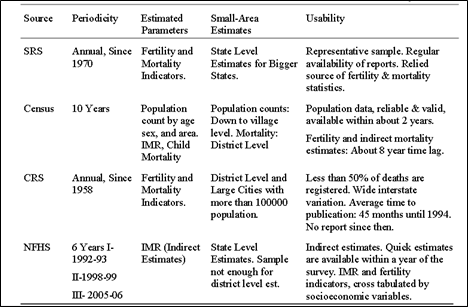
Major Findings of the Report
- Population Composition shows rise in working population: As per available data from SRS, India is not getting younger anymore; while the working population is on the rise.
- There has been a gradual decline in the share of population in the age group 0-14 at 25.3% of the overall population in 2019 from 41.2% in 1971.
- The proportion of economically active population (15-59 years) has increased from 1971 to 2019.
- On account of better education, health facilities and increase in life expectancy, the percentage of elderly population (60+) has gone up from 8% in 2019 from 5.3% in 1971.
- Despite the headline numbers, there are regional variations. For example, Bihar, Madhya Pradesh and Jharkhand were the three youngest states with the age group 0-14 years comprising over 30% of the population.
- Number of women married before 21 is declining. In 2019, about 37% of women in the country married before 21 years, with West Bengal having the highest numbers.
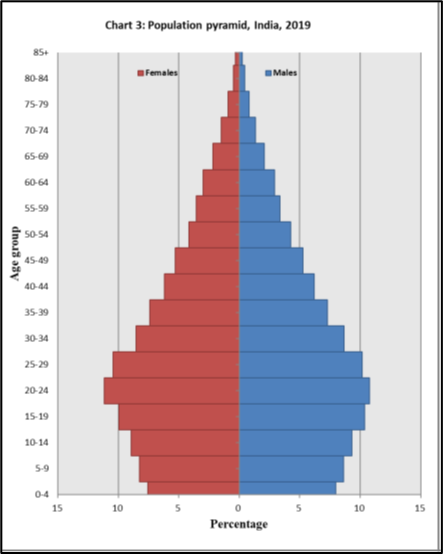
- Birth Rate is on the decline: The Crude Birth Rate (CBR) at the National level during 2019 stands at 19.7. During 1991-2019, the decline has been about 33 percent.
- The crude birth rate is the annual number of live births per 1,000 population.
- The maximum CBR has been reported in Bihar (25.8) and the minimum in Kerala (13.5).
- The corresponding decline in rural CBR is 1.3 points and in urban CBR 1.0 points.
- Sex Ratio at Birth for the country has gone up by 5 points to 904 in 2017-19 from 899 in 2016-2018. Kerala has reported the highest Sex Ratio at Birth (968) while Uttarakhand, the lowest (848).
- TFR has been declining: Total Fertility Rate (TFR) for the country has come down to 2.1 in 2019 after being stable at 2.2 for the last two years 2017 and 2018.
- TFR is expressed as children per woman.
- During 2019, Bihar has reported the highest TFR (3.1) while Andhra Pradesh, Delhi, Jammu & Kashmir, Punjab, Tamil Nadu and West Bengal have reported the lowest TFR (1.5).
- There has been decline of 0.2 points in rural and 0.1 point in urban during the corresponding period.
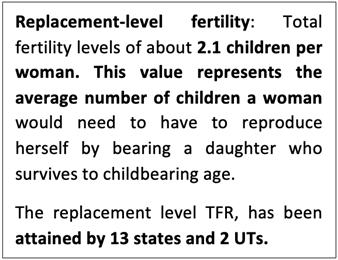
- Mortality rate in India has declined: The Crude Death Rate (CDR) for the country is 6.0 in 2019.
- The maximum CDR has been reported for Chhattisgarh (7.3) and the minimum for Delhi (3.2).
- During the last five years, the decline in National CDR has been to the tune of 0.7 points.
- The corresponding decline in female CDR is 0.6 points whereas in male CDR it is 1.2 points.

- Child Mortality Rates have decreased: The Infant Mortality Rate (IMR) has also registered 2-point decline to 30 in 2019 from 32 in 2018 at the National level. The maximum IMR has been observed in Madhya Pradesh (46) and the minimum in Kerala (6).
- IMR for the country has come down to 30 in 2019 from 39 in 2014. The corresponding decline in rural IMR has been to the tune of 9 points against a decline of 6 points in urban IMR. Both the gender have shown decline in the period 2014-19.
- Despite this decline, one in every 33 infants at the National level, one in every 29 infants in rural areas and one in every 50 infants in urban areas still die within one year of life.
- In 2019, Under 5 Mortality Rate (U5MR) for the country has shown a decline of 1 point over 2019. There has been a decline of 1 point in male U5MR and 2 points in female U5MR during the corresponding period.
- Medical care has improved: Overall, India has seen better medical care facilities over the years in case of either birth or death.
- At the National level, 7 percent births were attended by Government Hospitals and vary from 54.1 percent in rural areas to 56.4 percent in urban areas. About 28.1 percent of births occurred at Private Hospital.
- There has been an increase of 0.8 percentage points in 2019 (48.6) over 2018 (47.8) in case of deaths where the deceased have received medical attention before death, either at Government hospital or at Private hospital.
Sources:
Diébédo Francis Kéré
This is image of Francis Kéré’s work. Francis Kéré (born Diébédo Francis Kéré) is the first Black person to receive architecture’s highest honour, the Pritzker Prize. The architect’s work is largely focused in areas facing adversity and constraints, and on using local materials and catering to local needs. He has designed several schools and medical facilities. He has developed a sensitive, bottom-up approach in its embrace of community participation. His cultural sensitivity not only delivers social and environmental justice, but guides his entire process, in the awareness that it is the path towards the legitimacy of a building in a community. The circumstances he grew up in, and observing the spaces around him, have contributed to Kéré’s architectural sensibilities.
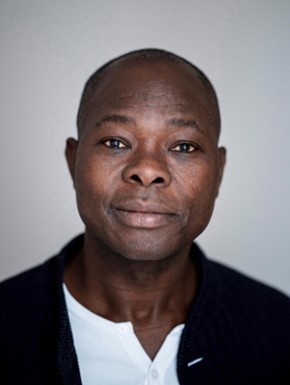

Source:
Boma technique
- Context: Boma technique has been recently adopted for translocating deer from Keoladeo National Park in Rajasthan.
- The Boma capturing technique is a popular technique in Africa that involves luring of animals into an enclosure by chasing them through a funnel-like fencing.
- The funnel tapers into an animal selection-cum-loading chute, supported with grass mats and green net to make it opaque for animals, which are herded into a large vehicle for their transport to another location.
- This technique was earlier utilised to capture wild elephants for training and service.
- Being adopted in Madhya Pradesh in recent years, Boma has been put to practice for the first time in Rajasthan at Keoladeo National Park for capturing and translocating spotted deer to improve the prey base (for tigers and leopards) in Mukundara Hills Tiger Reserve, situated 450 km away.

Source:
- Boma technique adopted for translocating deer from Keoladeo
- South African Boma technique used in Madhya Pradesh to capture Nilgai
Image source:
Ujjwala Effect’
- Context: According to the first independent impact assessment of the Ujjwala programme, the scheme is noted to have prevented at least 1.5 lakh pollution-related premature deaths in 2019.
- This attributes to the greater penetration and usage of LPG as a cooking fuelthat in addition to preventing deaths (13% reduction in deaths), has also helped in avoiding at least 1.8 million tonnes of PM2.5 emissions that year.
- The Pradhan Mantri Ujjwala Yojana (PMUY) was launched in 2016 with the objective of providing LPG connection to households that were using traditional fuels like wood, cow-dung cakes or coal for cooking purposes which release lot of pollutants and are damaging to the health of the people, particularly women engaged in kitchen.
- The target was to provide 8 crore new LPG connections by 2020.
- This target was achieved way back in 2019 and the current data shows that 8% of the 28 crore households in India now have access to LPG, up from 61.9% in 2015.
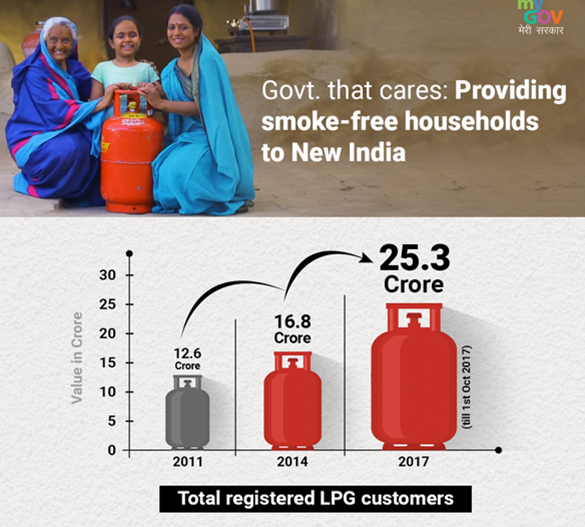
Source:
- ‘Ujjwala Effect’: Study estimates over 1.5 lakh lives saved in a year, 13% reduction in air pollution deaths
- Pradhan Mantri Ujjwala Yojana 2.0
Image source:
Humanitarian Corridors
- Context: Amid the Ukraine war, Russia has announced ‘humanitarian corridors’ to allow citizens to flee from the cities of Chernihiv, Sumy, Kharkiv, Mariupol and Kyiv.
- A humanitarian corridor is a type of temporary demilitarized zone intended to allow the safe transit of humanitarian aid and the refugees out of a crisis region.
- They are safe passages that are created in a war zone by halting hostilities for a certain time-either to allow civilians to flee using designated routes.
- These corridors also allow food and medical aid to be brought to the areas of conflict.
- Over 3.1 million people have been estimated to have fled Ukraine to neighbouring countries in the last three weeks out of which about 2 million people have been accepted to seek asylum in Poland.
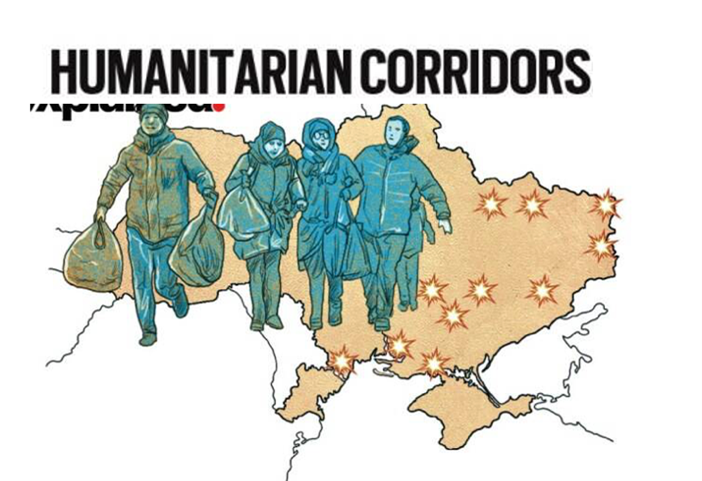
Source:
- Ukraine war: What are humanitarian corridors, and how safe are they?
- ICRC willing to facilitate evacuation via humanitarian corridors in Ukraine: President
Image source:
Doordarshan
- Context:DD India has recently joined hands with Yupp TV to expand its global reach.
- With this, DD India will now be available to its viewersthrough an over-the-top (OTT) platform in several countries including the US, UK and Australia.
- The move is part of the publicbroadcaster's "vision" to expand its global reach to put forth India's perspective on various international developments on global platforms and showcase its culture and values to the world
- Doordarshanis an autonomous public service broadcaster founded by the Government of India.
- It isone of two divisions of Prasar Bharati and is one of India’s largest broadcasting organisations in terms of studio and transmitter infrastructure, established 1959.
- DD providestelevision, online and mobile services throughout metropolitan and regional India, as well as overseas, through satellite network.
- Available inmore than 190 countries, DD India also acts as a "bridge between India and the Indian diaspora" spread across the world.

Source:
Image source:
The pandemic’s income inequality surprise: IE
Essence: India has suffered greatly due to covid pandemic. At the macro level, the economy underwent a V shaped recovery. To understand what happened at the micro level, Consumer Pyramids Household Survey (CPHS) offers some answers. During the lockdown, the fraction of the population in extreme poverty rose from 7.6 per cent in November 2019 to 50.5 per cent in April 2020 and income inequality spiked by 25 per cent and 15 per cent in urban and rural areas respectively.
After the lockdown, poverty did not return to the pre-pandemic levels and is 4 percentage points higher than before Covid-19. However, income inequality reached to below pre-pandemic levels. This decline in inequality was driven by an increase in social mobility i.e., increase in income percentile.
Why should you read this article?
- To know the findings of the Consumer Pyramids Household Survey (CPHS).
- To know the pre and post pandemic income and inequality levels.
- To understands the reasons for income inequality dropping to less than pre-pandemic levels.
Source:
India and the quad: ORF
Essence: The editorial talks about the history of quad, its evolution and significance, challenges in front of it and how the grouping has diversified its objective. Quad’s precursor, the ‘core group’ to aid humanitarian relief got formed after the 2004 tsunami. Japan later led to the formation of ‘the arc of freedom and prosperity’ and Singapore the initiation of Malabar exercises.
Later, Chinese protests led to an eight-year hiatus, broken by India’s renewed vigor and participation in 2017, as a show of strength in the backdrop of Doklam standoff and later 2020 Galwan valley clashes. India has now shown active expertise in pharmaceuticals, supply chain, technology production capacity, etc.
Due to dominance and aggression faced by south-east Asian countries, countries started to adopted policies like SAGAR (Security and Growth of All in the Region) and IPOI (Indo Pacific Oceans Initiative), CT-TTX (Counter-terrorism table-top exercise), etc. Sharing of logistics, military information, naval exercises has translated into vaccine delivery, climate change and technology, supply chain resilience initiative, 5G, etc.
Quad poses threat by undermining the significance of regional groupings like BRICS, SCO, alienating relations with countries like Iran and Myanmar and inactivity in BRI. But overall, Quad holds the key to counterbalance the regional hegemon China and preferred mode of engagement in the new diplomatic era.
Why should you read this article?
- To know about the history and evolution of quad.
- To know the operational dynamics of India in quad.
Source:
Stitching Livelihood - Edukemy Current Affairs
Background
Covid-19 pandemic took away the livelihood options of the vulnerable sections of the society, especially the ones living in the lowlands known as Chars in Assam.

How Women are Stitching Livelihood on the Char?
- The women of the Rupakuchi island on the Beki River of Assam are working towards making a livelihood through stitching khetas.
- Khetas or patchwork quilt is a centuries old Bengali Handicraft where old cloth are used and stitched into quilt.
- The people on this island lived a sedentary life with meagre resources, and lack of socio-political
- NGO Amrapari came forward to help the women of Char to earn a livelihood with the handicraft. But, the Ngo provided the women new cloth for stitching to get a better value.
- The NGO helps in selling off the products online for better market availability and also on their their own website.
Quote: “Culture does not make people. People make culture. If it is true that the full humanity of women is not our culture, then we can and must make it our culture.” - Chimamanda Ngozi Adichie.
Source:
Share the article
Get Latest Updates on Offers, Event dates, and free Mentorship sessions.

Get in touch with our Expert Academic Counsellors 👋
FAQs
UPSC Daily Current Affairs focuses on learning current events on a daily basis. An aspirant needs to study regular and updated information about current events, news, and relevant topics that are important for UPSC aspirants. It covers national and international affairs, government policies, socio-economic issues, science and technology advancements, and more.
UPSC Daily Current Affairs provides aspirants with a concise and comprehensive overview of the latest happenings and developments across various fields. It helps aspirants stay updated with current affairs and provides them with valuable insights and analysis, which are essential for answering questions in the UPSC examinations. It enhances their knowledge, analytical skills, and ability to connect current affairs with the UPSC syllabus.
UPSC Daily Current Affairs covers a wide range of topics, including politics, economics, science and technology, environment, social issues, governance, international relations, and more. It offers news summaries, in-depth analyses, editorials, opinion pieces, and relevant study materials. It also provides practice questions and quizzes to help aspirants test their understanding of current affairs.
Edukemy's UPSC Daily Current Affairs can be accessed through:
- UPSC Daily Current Affairs can be accessed through Current Affairs tab at the top of the Main Page of Edukemy.
- Edukemy Mobile app: The Daily Current Affairs can also be access through Edukemy Mobile App.
- Social media: Follow Edukemy’s official social media accounts or pages that provide UPSC Daily Current Affairs updates, including Facebook, Twitter, or Telegram channels.


